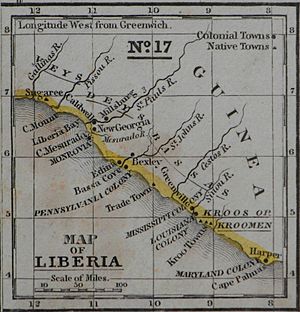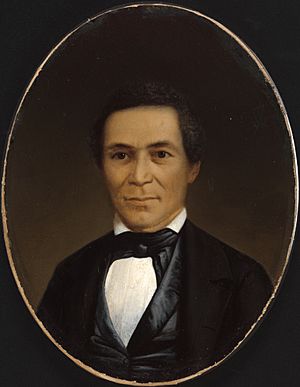Republic of Maryland facts for kids
Quick facts for kids
Colony of Maryland in Africa
|
|||||||
|---|---|---|---|---|---|---|---|
|
Flag (1854–57)
|
|||||||

Map of modern-day Maryland County in Liberia
|
|||||||
| Status | Private Colony of the Maryland State Colonization Society (1834–54) Republic (1854–57) |
||||||
| Capital | Harper | ||||||
| Common languages | English (de facto) Grebo |
||||||
| Religion | Christianity | ||||||
| Government | Private Colony of the Maryland State Colonization Society (1834–54) Republican Government(1854–57) |
||||||
| Governor | |||||||
|
• 1836–51
|
John Brown Russwurm | ||||||
|
• 1854
|
Samuel Ford McGill | ||||||
|
• 1854–56
|
William A. Prout | ||||||
| History | |||||||
|
• Establishment as colony
|
February 12, 1834 | ||||||
|
• Independence
referendum |
January 31, 1853 | ||||||
|
• Declaration
of independence |
May 29, 1854 | ||||||
|
• Annexed by Liberia
|
March 18, 1857 | ||||||
| Currency | United States dollar | ||||||
|
|||||||
The Republic of Maryland (also called Maryland-in-Africa or Maryland in Liberia) was a country in West Africa. It existed from 1834 to 1857. After this, it joined with what is now Liberia.
The area was first settled in 1834. The settlers were mostly African-American people who had been freed from slavery. There were also freeborn African Americans from the U.S. state of Maryland. They came to Africa with help from the Maryland State Colonization Society.
The larger American Colonization Society was started in 1816. It helped thousands of free African Americans move to its colony of Liberia. Other states like Mississippi and Kentucky also started their own colonies.
In 1838, many of these settlements joined together to form the Commonwealth of Liberia. This group declared its independence on July 26, 1847. However, the Maryland colony stayed separate. The Maryland colonization society wanted to keep control over trade in its area.
On February 2, 1841, Maryland-in-Africa became the Independent State of Maryland. After a vote in 1853, it declared full independence on May 29, 1854. It was then called Maryland in Liberia, with its capital city at Harper.
Contents
History of Maryland in Africa
The American Colonization Society was founded in 1816. One reason for its creation was the Haitian Revolution. This was a slave uprising that led to Haiti's independence in 1804. People in the U.S. worried about similar events if slaves were freed.
During this time, both slave owners and people who wanted to end slavery supported sending free Black people to Africa. Slave owners thought free Black people might cause problems for their slave societies. For example, Nat Turner's rebellion in 1831 made Southerners very afraid.
Abolitionists, who wanted to end slavery, hoped that slave owners would free their slaves. They also worried about the unfair treatment free Black people faced in the United States. Supporters of relocation believed that African Americans could build better communities in Africa. They thought these communities would be free from prejudice and unfair treatment.
However, most free African Americans did not support this idea. They felt they had a right to live in the United States, where they were born. They wanted to improve their lives there.
The state of Maryland had a growing number of free Black people. After the American Revolution, many slaves were freed. By 1830, over half of the Black population in northern Maryland was free. Many of them lived in Baltimore, a large city.
The Maryland State Colonization Society was a part of the American Colonization Society. The main society had started the colony of Liberia in 1822. The Maryland Society decided to create its own settlement. This was to help its own settlers and control trade. In 1831, Maryland's state government gave money to help transport free Black people and former slaves to Africa.
Settling Cape Palmas
The first area settled by the Maryland Colonization Society was Cape Palmas in 1834. This area was a bit south of the main Liberian colony. Cape Palmas is a small, rocky piece of land connected to the mainland by sand.
Most of the settlers were African Americans from the state of Maryland. The Colonization Society hoped to create new trade connections by moving these people to West Africa. The colony was named Maryland in Africa on February 12, 1834. It was also known as Maryland in Liberia.
John Brown Russwurm, a Key Leader
In 1836, John Brown Russwurm (1799–1851) became the first mixed-race governor of the colony. He served for over ten years until he died. Russwurm encouraged more African Americans to move to Maryland in Africa. He also supported farming and trade.
Before becoming governor, Russwurm worked for the American Colonization Society. He was also the editor of a newspaper called the Liberia Herald. He left that job in 1835 because he disagreed with some of America's colonization policies.
In 1838, several other American settlements in West Africa joined to form the Commonwealth of Liberia. This group declared its independence on July 26, 1847.
In 1851, two American visitors reported that "Maryland in Liberia" had about 900 to 1,000 people. It had four churches and six schools.
The colony of Maryland in Liberia remained independent. The Maryland State Colonization Society wanted to keep its control over trade in the area. On February 2, 1841, Maryland-in-Africa declared itself a state. In 1847, the Maryland State Colonization Society published a constitution for Maryland in Liberia. It was based on the United States Constitution.
Independence and Joining Liberia
On May 29, 1854, the State of Maryland declared its full independence. It called itself Maryland in Liberia, or the Republic of Maryland. Its capital was Harper. It controlled the land along the coast between the Grand Cess and San Pedro rivers. It was an independent state for three years.
Soon after, local tribes, including the Grebo and the Kru, attacked the State of Maryland. The new country could not defend itself alone. So, Maryland asked Liberia, its stronger neighbor, for help.
Liberian President Roberts sent military aid. An alliance of Marylanders and Liberian soldiers successfully pushed back the tribesmen. The Republic of Maryland realized it could not survive as an independent country. After a vote, Maryland joined Liberia on April 6, 1857. It then became known as Maryland County within Liberia.
Legacy
A statue of John Brown Russwurm was put up near his burial place in Harper, Cape Palmas, Liberia.
Governors of Maryland-in-Africa
| Term | Incumbent |
|---|---|
| February 12, 1834 – February 1836 | James Hall, Governor, Maryland in Africa |
| February 1836 – July 1, 1836 | Oliver Holmes Jr., Governor, Maryland in Africa |
| July 1, 1836 – September 28, 1836 | Three-member Committee, Maryland in Africa |
| September 28, 1836 – February 2, 1841 | John Brown Russwurm, Governor, Maryland in Africa |
| February 2, 1841 – June 9, 1851 | John Brown Russwurm, Governor, State of Maryland in Liberia |
| June 9, 1851 – 1852 | Samuel Ford McGill, acting Governor, State of Maryland in Liberia |
| 1852 – May 29, 1854 | Samuel Ford McGill, Governor, State of Maryland in Liberia |
| May 29, 1854 – June 8, 1854 | Samuel Ford McGill, Governor, The Independent State of Maryland in Liberia |
| June 8, 1854 – April 1856 | William A. Prout, Governor, The Independent State of Maryland in Liberia |
| April 1856 – March 18, 1857 | Boston Jenkins Drayton, Governor, The Independent State of Maryland in Liberia |
See also
 In Spanish: República de Maryland para niños
In Spanish: República de Maryland para niños





